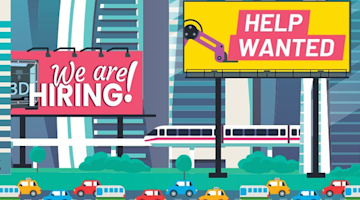In early October, AMT staff and members descended upon St. Louis with a sense of anticipation and caution, much like the stream of settlers who had begun their journey west centuries before. Unlike the settlers, St. Louis was the endpoint of their travels: the location of the annual MTForecast conference. After a year of mixed signals from economic data and a summer of pessimistic outlooks, everyone was eager to hear the story behind the data and the expectations for the future. This article will look at some of the unique economic conditions leading up to the conference as well as a few key insights shared by the economists on the likely direction ahead. To better understand the likely paths before us, it is first critical to review the economic roads that brought us to this point.
The first half of 2022 was met with an ominous economic signal: two consecutive quarters of declining gross domestic product (GDP). Since GDP measures the total output of a country, this generally signals that its economy is in recession. Unlike most recessions, this period was defined by an unusually low unemployment rate and high consumer demand. Economists at MTForecast pointed out that the observed GDP contraction was more the result of supply challenges than the demand-driven downturn that causes most recessions. While that may sound like a positive spin, an economy afflicted by persistent supply issues can be nearly as painful as one afflicted by a demand-driven recession. Since the conclusion of MTForecast, third quarter GDP was published and, as anticipated, showed signs of a growing economy. Inventory depletion, which was a main driver of the negative print in the first two quarters, moderated, and third quarter growth was driven by increases in investment and government spending. In perhaps a foreshadowing of soft economic conditions, the release indicated that consumer spending was decelerating. Up to this point, consumer activity had been strong enough to keep the economy out of recession and will be key in determining if the economy remains growing for the remainder of the year.
Consumer Demand Skyrockets
Much has been written about the shift in consumer demand that happened at the beginning of 2020. With the service sector nearly shuttered, those who remained employed shifted their demand from services to manufactured goods, beginning the supply challenges that are still felt today. In the early stages of the pandemic, demand for manufactured goods dropped just like the rest of the economy, but as people settled into life at home and federal stimulus plans began to shore up budgets as state governments processed a record number of unemployment claims, demand for goods quickly rebounded.
Consumer spending on durable goods exceeded pre-recession levels just four months after the onset of the COVID recession. By comparison, it took over five years for consumer spending on durable goods to surpass pre-recession levels after the 2008 financial crisis. Within a year of the COVID shutdowns, durable goods spending had exceeded the growth realized between the end of the financial crisis and the onset of the 2020 recession. To date, consumer spending on durable goods remains at astronomical levels. Despite inflation, this demand has been propped up by a massive arsenal of savings, increased reliance on revolving credit lines, and an extremely favorable labor market that has seen incredible wage growth. Subsequently, the rate of consumer savings has fallen well below pre-pandemic levels as many people who accrued savings have begun to draw on them to fund further consumption. Conversely, revolving consumer credit balances began to decline in February 2020, and that trend reversed just over a year later. It now exceeds its pre-recession peak. While both savings and credit have allowed continued spending despite high inflation, their impact can only be temporary, whereas rapid wage growth in the exceptionally tight labor market has provided a more sustainable source of funding for continued consumption.
Demand for Labor Rises
Since early 2018, the labor market had been unusually tight, with slightly more than one job available for every unemployed worker. This ratio collapsed at the onset of the COVID recession and has rebounded to a historic level. For several months in a row, there were nearly two jobs for every person who was out of work and seeking employment. The return of numerous jobs lost during the shutdown and resulting recession, as well as new jobs created from manufacturers reshoring production to shorten supply chains, drove the increase in job openings. At the same time, the number of available workers fell, as many have yet to return to the labor force.
Labor force participation had been on a downward trend since the onset of the 2008 financial crisis. During periods of recession, people close to retirement tend to leave the labor force instead of seeking employment elsewhere, depressing the participation rate. In 2008, older baby boomers were just shy of retirement age, and as time went on, more baby boomers exited the labor force, resulting in a downward trend in labor force participation. Following the COVID recession, the participation rate, already weakened from retirements, dipped dramatically and seems to have plateaued about one percentage point below the previous trend.
While there are several possible explanations for the depressed labor participation, the net effect is an extraordinarily tight labor market that has resulted in large wage increases in a short period of time. Although these wage increases are not keeping pace with inflation, they go a long way in supplementing incomes to better adapt to an environment of rising prices. Unfortunately, these wage gains also increase inflationary pressures. While the cost of goods tends to fluctuate based on supply and demand dynamics, once raised, wages tend to remain elevated, prolonging their upward pressure on inflation.
Inflation Takes Hold
As a result of the unique demand dynamics described above, coupled with supply challenges, inflation took hold of the U.S. economy in a way not seen in decades. Despite aggressive rate hikes from the Federal Reserve, core inflation has remained persistently high and is projected to remain at an elevated level into 2023. By making borrowing more costly, the Federal Reserve hopes to reduce demand by enough that inflation will begin to reduce toward the 2% target without reducing it enough to trigger a recession. The side consequence of the aggressive interest rate policy is the strengthening of the U.S. dollar relative to other currencies. As this happens, demand for U.S. goods could fall off in favor of foreign alternatives. Given the supply chain issues in some markets, this may have a more muted effect than usual, but it raises the prospects that the trade balance will weigh down GDP in the future. As the United States imports more at a lower price and exports less because of the relatively higher prices, this negative trade balance will be subtracted from GDP.
What the MTForecast Experts Say
Tracing that economic path to the present, the economists at MTForecast predicted a modest decline in GDP beginning in the first half of 2023. Unlike the declines seen in the beginning of 2022, the economy is likely to find itself solidly in recessionary territory. As price pressures mount and credit becomes more expensive, consumers will begin to ease demand. The second half of 2023 will likely be positive, but the gains may not equal the decline of the first half, so the year could end down overall. A positive note highlighted by the forecasters was the likelihood the recession would be mild and quick. Given the massive number of job openings, the onset of a recession will likely be characterized by a decrease in hiring before actual layoffs, resulting in one of the lowest forecasted unemployment levels during a recession ever. This decrease in demand is also likely to help alleviate some of the supply issues that have constrained the economy since the onset of the COVID recession. This will allow many producers to chip away at their backlogs and accumulate inventories ahead of the rebound in demand during the second half.
The conversion of those backlogged orders into deliveries during the first half of 2023 means that there will be several areas of opportunity for manufacturing technology despite an overall economic contraction. Economists at MTForecast highlighted several industries that were in a position to increase their capital investment in the coming months. Many of these industries have benefited from recent government spending on infrastructure and procurement for defense. Although some industries are projected to fare well in the coming months, the path ahead is not entirely clear. The Federal Reserve’s singular focus on curbing inflation is designed to rein in overheated demand, but if taken too far, it could also begin to discourage capital investment reliant on financing. Thus far, the increases have been justified by the persistently tight labor market. Should data begin to show a decrease in job availability or an increase in unemployment, the Federal Reserve will begin to slow or halt their rate increases to balance the loosening of the labor market with the cooling of consumer demand. Economists at MTForecast projected the beginning of 2023 may see an easing of interest rate moves as the Fed attempts to tiptoe toward the inflection point of inflation rather than march past it, which would trigger a wider recession. Keeping an eye both on the monthly inflation report as well as job numbers will offer insights into the likely trajectory of future interest rate moves.
The last few years have been characterized by conflicting data points, first-in-a-generation events, and a reassessment of how some facets of our economy work. Like the settlers of the past, St. Louis served as a gathering place to acquire tools, supplies, and knowledge before traveling into unknown territory. As we wade through uncharted economic territory, St. Louis once again served as the gathering place to share knowledge, gather tools, and chart a course into the future.
If you attended MTForecast 2022 and would like to access the full presentations, forecasts, and outlooks, just log in to your account at MTForecast.com. If you have any questions about this information, please contact Chris at cchidzik@AMTonline.org.






